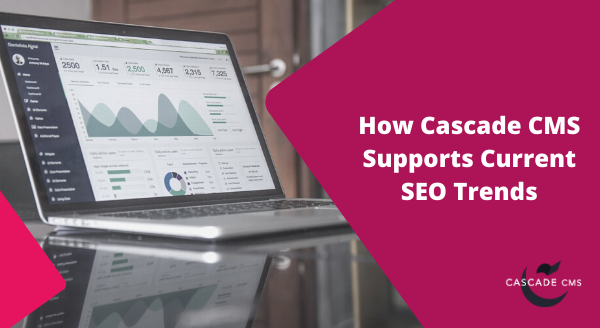
Search engine optimization (SEO) is the practice of increasing the quantity and quality of traffic to your website through organic search results. Search engines use crawlers to gather information about all of the content they can find on the Internet, and that index is fed through an algorithm that matches data with search queries. (source: Moz)
But this isn’t a magic process. There are factors within our control that can help the algorithm rank our content more favorably. The top five most important ranking factors are:
And when it comes to the optimization component of SEO, be sure to use title tags, meta descriptions, and a strong internal linking structure so readers can understand (and enjoy!) the content you’re presenting.
Building an SEO-friendly site requires choosing a great domain name, learning how to acquire links from other websites, writing keyword-rich content, and more. And while these tactics and requirements are constantly evolving, Cascade CMS supports many current SEO trends that can help your organization plan its strategy.
Voice Search Will Impact Search Queries
To optimize for voice search, it’s important to consider how voice is different from typed queries, and how to adjust your keywords accordingly. For example, voice searches tend to be longer, more complete phrases compared to abbreviated typed searches.
Cascade CMS can enforce the entry of pertinent metadata like title, description, and keywords. All assets within the system—whether pages, content blocks, images, or other files—can be given metadata values, which can be preset as default for new content based on its type or use.
Mobile-Friendliness Will Impact Search Rankings
It’s well known that Google enforces mobile-first indexing, which means the mobile version of your website is considered primary over the desktop version. Cascade CMS provides a straightforward templating system for creating responsive sites.
Templates in Cascade CMS are just valid XHTML, the system fully supports HTML5 and CSS3 for the creation of responsive sites, and it offers the flexibility of using either Velocity or XSLT to write formats. Additionally, you can develop new templates outside of Cascade CMS using a responsive framework like Bootstrap or Foundation, and seamlessly bring them into the system.
Snippets are a Great Way to Get on First-Page Results
Not only can snippets steal traffic away from competitors, they are a great way to gain prominence without creating long-form content. To be featured in a snippet, focus on question-based queries and relevant keywords, and keep in mind that some users prefer “zero-click” searches (meaning they find a satisfactory answer to their query in the snippet alone).
Again, require metadata fields, including keywords, to be filled out by end users. Train content contributors to write copy with common searches in mind, using keywords throughout their work.
Pro tip: use Google’s “people also ask” for inspiration. Start typing a phrase you think prospective students are searching, for example, to see the "people also ask" expansion.
Effective SEO Includes Video
Video is rapidly rising in popularity, and, according to the Cisco Annual Internet Report, is projected to surpass all other content forms in terms of consumption. Optimize your YouTube channel name and write a user-friendly overview. Think about the keywords people will use to find your video, and include those in titles and descriptions.
When it comes to promoting videos on your corporate website, Cascade CMS enables you to incorporate multimedia in several ways. For example, you can link to a video by simply copying a YouTube URL into a text field or pull in assets stored in a separate multimedia server.
Image Optimization Will Play a Large Role
In addition to using high-quality, relevant images, it’s more important than ever to customize file names, use alt text, and add images to your sitemap.
Images are treated like any other file asset in the CMS and are stored as such. Custom names, file size limitations, automatic resizing, and alt text can be enforced. We also have two digital asset management integrations that enable users to browse for and select images and assets directly from the WYSIWYG editor.
Additionally, Cascade CMS can automatically update your A-Z index page and your XML sitemap whenever a new piece of content has been created, renamed, or deleted.
Wrap Up
SEO seems to become more complex each year, so it is important to stay on top of trends and learn how Google indexes and ranks content. Metrics are always changing, so be diligent about improving or maintaining your spot in the rankings. And, finally, be sure to leverage all of the tools available within your CMS to optimize content and help search engines find, understand, and serve up your content.
For more information on increasing readership organically, check out our blog post Five Techniques to Boost Content Marketing ROI.Last Updated: Feb 23, 2021 2:00 PM